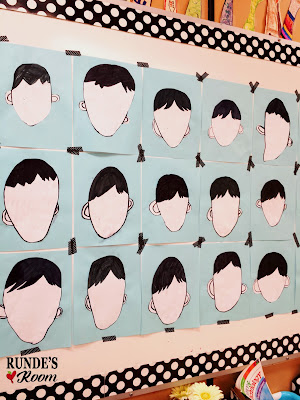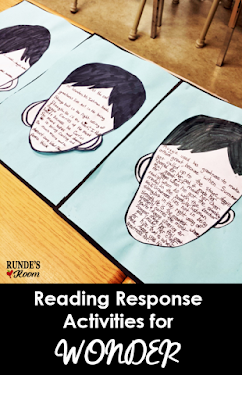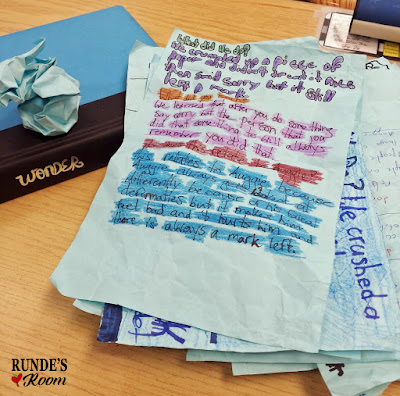If you follow me on Instagram, you already know that we have just finished Wonder by RJ Palacio as our read aloud ... but not wanting to give up Auggie just yet, we're reading The Julian Chapter from Auggie and Me. A few people have asked me about what we did during our reading of the novel, so I decided to put together a blog post with some of our favorite activities.
For our daily read aloud, I usually read for about 10 - 15 minutes a day. I don't do a reading response for our read aloud every day - usually about 2 to 3 a week, though (through our independent and shared reading, they have a lot comprehension and response minilessons so we have other avenues for practice). I also like to switch up our format a bit - bored learners are not engaged learners. We do have a reading response notebook where we do a lot of our responses, but we like to use other formats as well.
We completed one of our first favorites early on in the novel, and was a great tie-in to teaching empathy. Perhaps you've seen images from an anti-bullying lesson and crumpled paper - that one stuck with me from the minute I saw it. (There are many examples all over the web, but you can read a little more about it HERE.) I knew it would be a great lesson to go along with Wonder. We talked about how it would feel to be Auggie - to have people stare and call names. I then handed out a small piece of paper to each student. I told the students to call the paper names and say mean things to it - the kinds of things Auggie may have overheard. They were to crumple the paper in a ball as they were doing this, being responsible for the paper getting smaller and smaller and more destroyed. I then had them apologize to the paper, over and over, as they tried to smooth it out and make it "better". We talked about how the paper never went back to the way it was before - even when they tried to make it better, the marks and scars were still visible. They thought this was pretty powerful. I then had them use this paper to do their reader response on. I asked them three questions to respond to on the paper:
 Sometimes I just changed up the way we answered questions, instead of having them answer in their notebooks. I would write a quote on the whiteboard and they could respond right on the whiteboard, or use sticky notes to take notes while I was reading and post them after, and I also used a lot of printables from my Building Better Reading Responses and Stick-It-Together editable templates because they reinforced the reading response goals we were working on. I didn't have a set list of questions from the novel to choose from, instead, I came up with a question after our reading each day, thinking about the parts that really seemed to stick with the students or became great discussion starters. (You'll see color coding on some of our reading responses - this comes from our Reading Response Goals from my Building Better Reading Responses resource.)
Sometimes I just changed up the way we answered questions, instead of having them answer in their notebooks. I would write a quote on the whiteboard and they could respond right on the whiteboard, or use sticky notes to take notes while I was reading and post them after, and I also used a lot of printables from my Building Better Reading Responses and Stick-It-Together editable templates because they reinforced the reading response goals we were working on. I didn't have a set list of questions from the novel to choose from, instead, I came up with a question after our reading each day, thinking about the parts that really seemed to stick with the students or became great discussion starters. (You'll see color coding on some of our reading responses - this comes from our Reading Response Goals from my Building Better Reading Responses resource.)
 I have a Stick-It-Together Novel resource full of comprehension questions for Wonder that cover a variety of reading skills. These collaborative reading responses are my absolute favorite group work activity. Each student is first accountable for writing their own answer on a sticky note, and then they work to "stick together" their answers to build the best collaborative answer containing parts of their own original answers. Using these pages on a regular basis really helps your students reading responses improve - the more the students worked collaboratively to revise their best answers, the more they included these kinds of revisions in their own answers. Click HERE or on the picture to take a peek at this resource.
I have a Stick-It-Together Novel resource full of comprehension questions for Wonder that cover a variety of reading skills. These collaborative reading responses are my absolute favorite group work activity. Each student is first accountable for writing their own answer on a sticky note, and then they work to "stick together" their answers to build the best collaborative answer containing parts of their own original answers. Using these pages on a regular basis really helps your students reading responses improve - the more the students worked collaboratively to revise their best answers, the more they included these kinds of revisions in their own answers. Click HERE or on the picture to take a peek at this resource.
 For our summative activity for the book, our last reading response, I knew I wanted to do something special. We started by doing directed drawings of the face shape on the cover of the book. I gave each student a piece of white paper, and just told them what to draw from looking at the image. For example, I said, start out by drawing a large oval in the middle of the page, with the top being a little flatter than the bottom. For the hair, make an upside down V about an inch from the top of the oval, a little to the right of the middle. I was also drawing the same picture on the board as I was giving the instructions, so they had something to follow along. When we were done we cut out the face shapes and glued them to a piece of blue paper. We loved how these turned out!
For our summative activity for the book, our last reading response, I knew I wanted to do something special. We started by doing directed drawings of the face shape on the cover of the book. I gave each student a piece of white paper, and just told them what to draw from looking at the image. For example, I said, start out by drawing a large oval in the middle of the page, with the top being a little flatter than the bottom. For the hair, make an upside down V about an inch from the top of the oval, a little to the right of the middle. I was also drawing the same picture on the board as I was giving the instructions, so they had something to follow along. When we were done we cut out the face shapes and glued them to a piece of blue paper. We loved how these turned out!
 And lastly, a fabulous way to wrap up the unit is having your students perform this super fun Wonder Drama Circle. Your students will LOVE getting to act out small parts of the novel, and they get to work on their oral fluency skills at the same time. Win.
And lastly, a fabulous way to wrap up the unit is having your students perform this super fun Wonder Drama Circle. Your students will LOVE getting to act out small parts of the novel, and they get to work on their oral fluency skills at the same time. Win.
9
For our daily read aloud, I usually read for about 10 - 15 minutes a day. I don't do a reading response for our read aloud every day - usually about 2 to 3 a week, though (through our independent and shared reading, they have a lot comprehension and response minilessons so we have other avenues for practice). I also like to switch up our format a bit - bored learners are not engaged learners. We do have a reading response notebook where we do a lot of our responses, but we like to use other formats as well.
We completed one of our first favorites early on in the novel, and was a great tie-in to teaching empathy. Perhaps you've seen images from an anti-bullying lesson and crumpled paper - that one stuck with me from the minute I saw it. (There are many examples all over the web, but you can read a little more about it HERE.) I knew it would be a great lesson to go along with Wonder. We talked about how it would feel to be Auggie - to have people stare and call names. I then handed out a small piece of paper to each student. I told the students to call the paper names and say mean things to it - the kinds of things Auggie may have overheard. They were to crumple the paper in a ball as they were doing this, being responsible for the paper getting smaller and smaller and more destroyed. I then had them apologize to the paper, over and over, as they tried to smooth it out and make it "better". We talked about how the paper never went back to the way it was before - even when they tried to make it better, the marks and scars were still visible. They thought this was pretty powerful. I then had them use this paper to do their reader response on. I asked them three questions to respond to on the paper:
- What did we do?
- What did you learn?
- How can you connect this activity to Auggie in Wonder?
 Sometimes I just changed up the way we answered questions, instead of having them answer in their notebooks. I would write a quote on the whiteboard and they could respond right on the whiteboard, or use sticky notes to take notes while I was reading and post them after, and I also used a lot of printables from my Building Better Reading Responses and Stick-It-Together editable templates because they reinforced the reading response goals we were working on. I didn't have a set list of questions from the novel to choose from, instead, I came up with a question after our reading each day, thinking about the parts that really seemed to stick with the students or became great discussion starters. (You'll see color coding on some of our reading responses - this comes from our Reading Response Goals from my Building Better Reading Responses resource.)
Sometimes I just changed up the way we answered questions, instead of having them answer in their notebooks. I would write a quote on the whiteboard and they could respond right on the whiteboard, or use sticky notes to take notes while I was reading and post them after, and I also used a lot of printables from my Building Better Reading Responses and Stick-It-Together editable templates because they reinforced the reading response goals we were working on. I didn't have a set list of questions from the novel to choose from, instead, I came up with a question after our reading each day, thinking about the parts that really seemed to stick with the students or became great discussion starters. (You'll see color coding on some of our reading responses - this comes from our Reading Response Goals from my Building Better Reading Responses resource.) I have a Stick-It-Together Novel resource full of comprehension questions for Wonder that cover a variety of reading skills. These collaborative reading responses are my absolute favorite group work activity. Each student is first accountable for writing their own answer on a sticky note, and then they work to "stick together" their answers to build the best collaborative answer containing parts of their own original answers. Using these pages on a regular basis really helps your students reading responses improve - the more the students worked collaboratively to revise their best answers, the more they included these kinds of revisions in their own answers. Click HERE or on the picture to take a peek at this resource.
I have a Stick-It-Together Novel resource full of comprehension questions for Wonder that cover a variety of reading skills. These collaborative reading responses are my absolute favorite group work activity. Each student is first accountable for writing their own answer on a sticky note, and then they work to "stick together" their answers to build the best collaborative answer containing parts of their own original answers. Using these pages on a regular basis really helps your students reading responses improve - the more the students worked collaboratively to revise their best answers, the more they included these kinds of revisions in their own answers. Click HERE or on the picture to take a peek at this resource. For our summative activity for the book, our last reading response, I knew I wanted to do something special. We started by doing directed drawings of the face shape on the cover of the book. I gave each student a piece of white paper, and just told them what to draw from looking at the image. For example, I said, start out by drawing a large oval in the middle of the page, with the top being a little flatter than the bottom. For the hair, make an upside down V about an inch from the top of the oval, a little to the right of the middle. I was also drawing the same picture on the board as I was giving the instructions, so they had something to follow along. When we were done we cut out the face shapes and glued them to a piece of blue paper. We loved how these turned out!
For our summative activity for the book, our last reading response, I knew I wanted to do something special. We started by doing directed drawings of the face shape on the cover of the book. I gave each student a piece of white paper, and just told them what to draw from looking at the image. For example, I said, start out by drawing a large oval in the middle of the page, with the top being a little flatter than the bottom. For the hair, make an upside down V about an inch from the top of the oval, a little to the right of the middle. I was also drawing the same picture on the board as I was giving the instructions, so they had something to follow along. When we were done we cut out the face shapes and glued them to a piece of blue paper. We loved how these turned out!
Our last reader response question was based on a event from Auggie's graduation. I wrote this on the board:
- At the end of Wonder, Mr. Tushman said, "Greatness lies not in being strong, but in the right using of strength. he is the greatest whose strength carries up the most hearts ...". Auggie won the Beecher medal because this quote applies to him. Explain, using evidence from the text, what this quote means and how it applies to Auggie. How did he use his greatness to make others great? It was a pretty deep question for my grade 4/5 class, but we've had many deep conversations throughout the novel, and they ROCKED it. Super proud teacher moment.
When they were done the rough drafts of their responses, they wrote their good copies right on the faces (they drew lines in pencil to write on). These turned out so wonderful! They made a great celebration and evidence of learning bulletin board, appropriately entitled, Choose Kind. :)
When you're reading a book that has so many great lessons, you just feel inspired to come up with some great lessons of your own. :)
 And lastly, a fabulous way to wrap up the unit is having your students perform this super fun Wonder Drama Circle. Your students will LOVE getting to act out small parts of the novel, and they get to work on their oral fluency skills at the same time. Win.
And lastly, a fabulous way to wrap up the unit is having your students perform this super fun Wonder Drama Circle. Your students will LOVE getting to act out small parts of the novel, and they get to work on their oral fluency skills at the same time. Win.
I'd love to hear about some of your must-do lessons to go along with Wonder. Leave a comment below about something you do in your room.











































